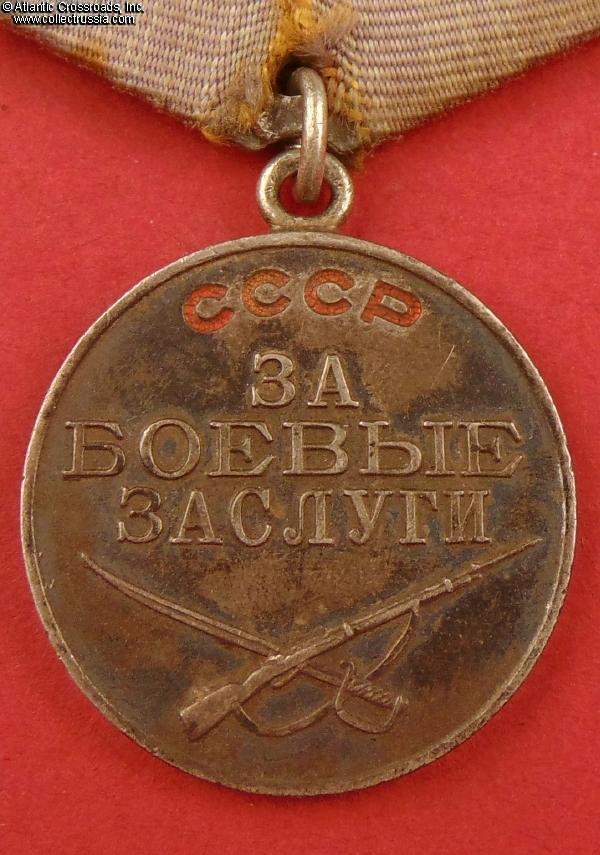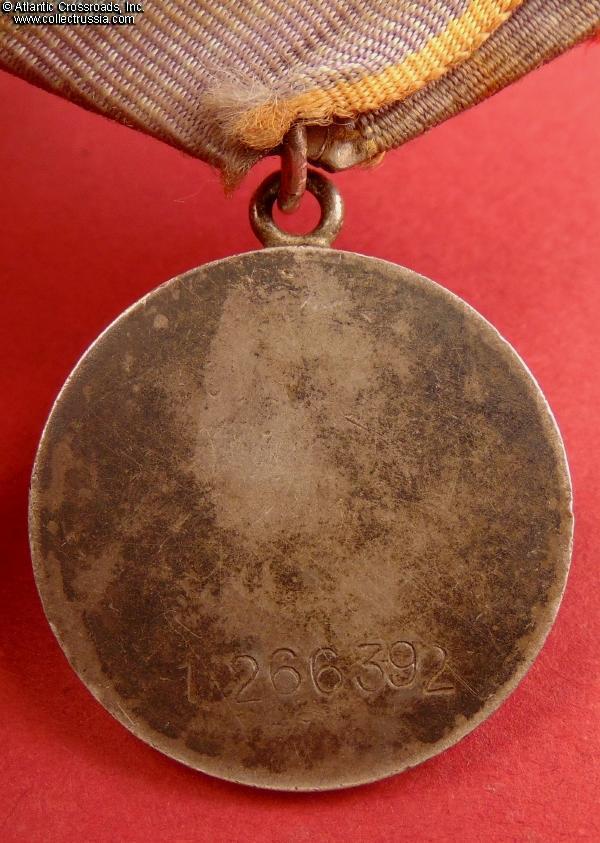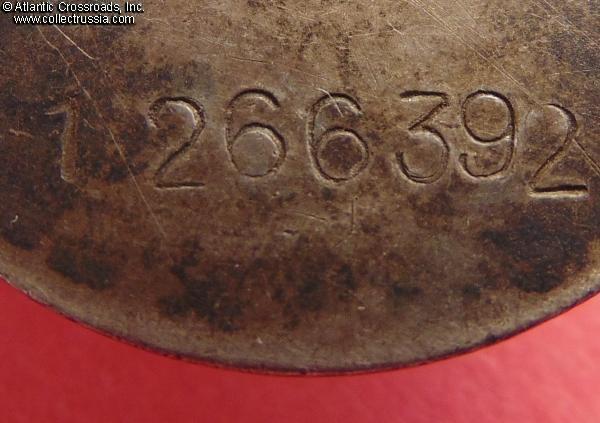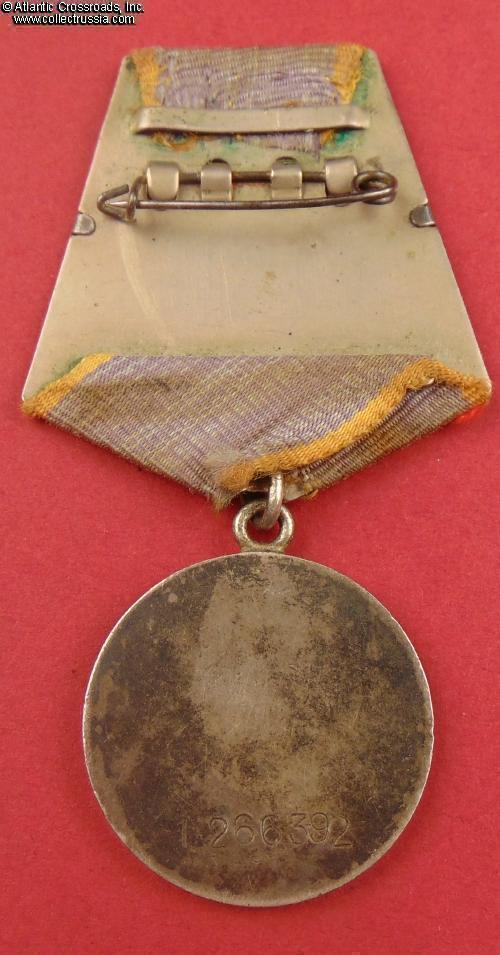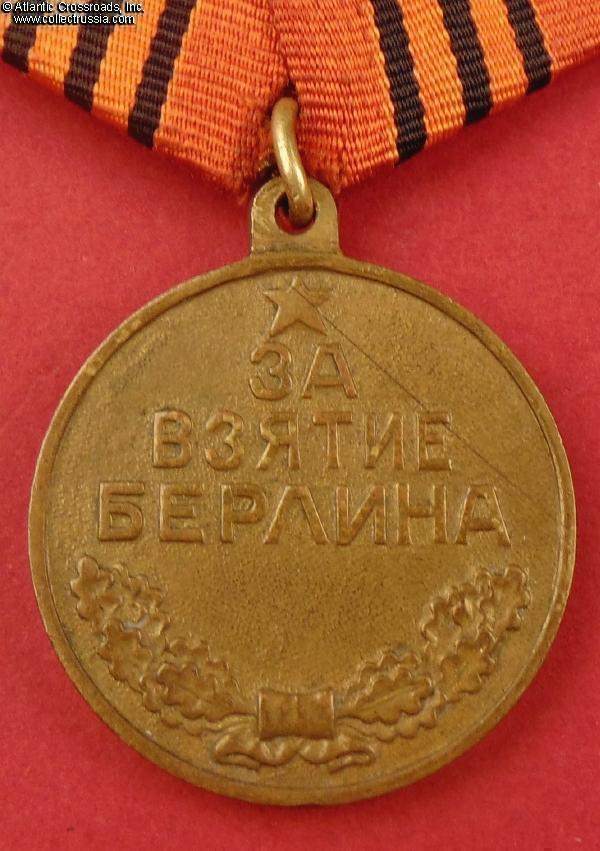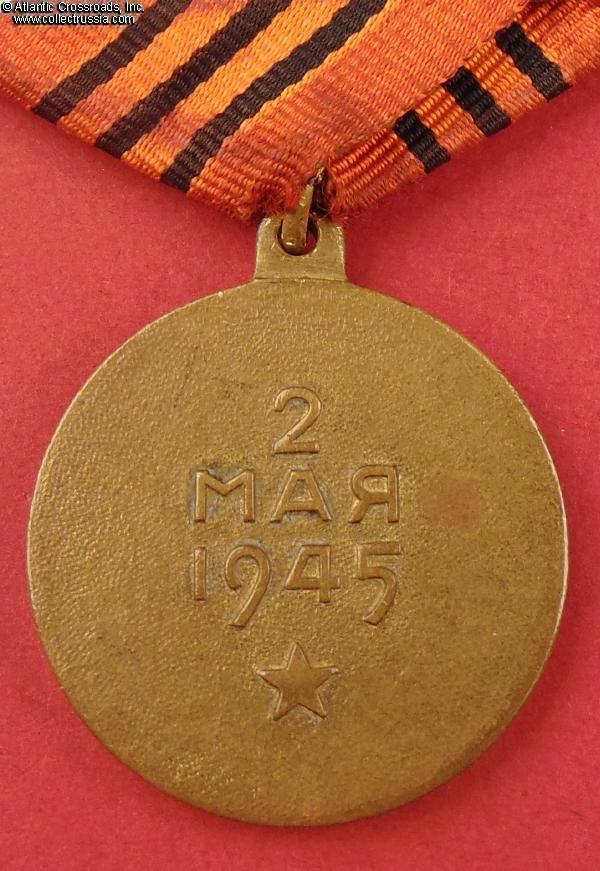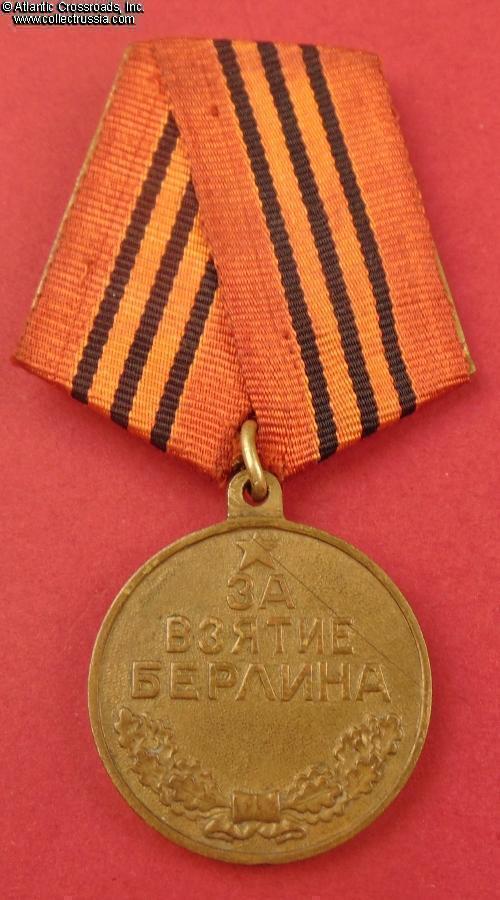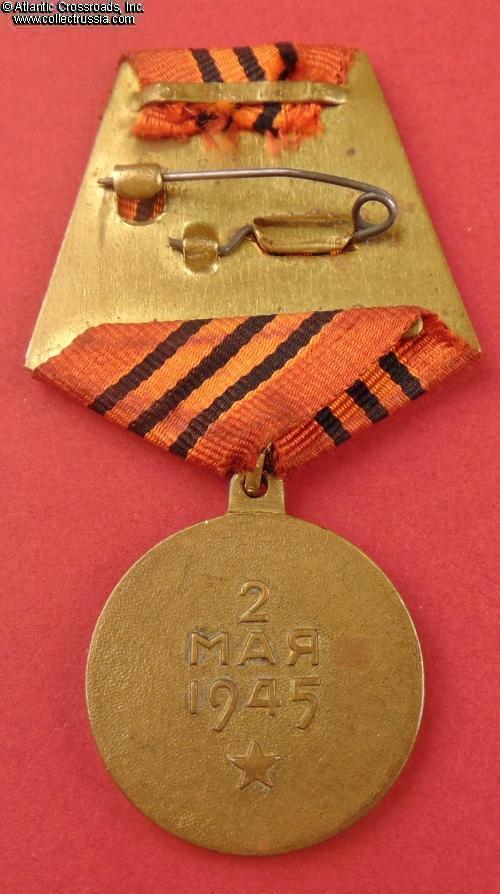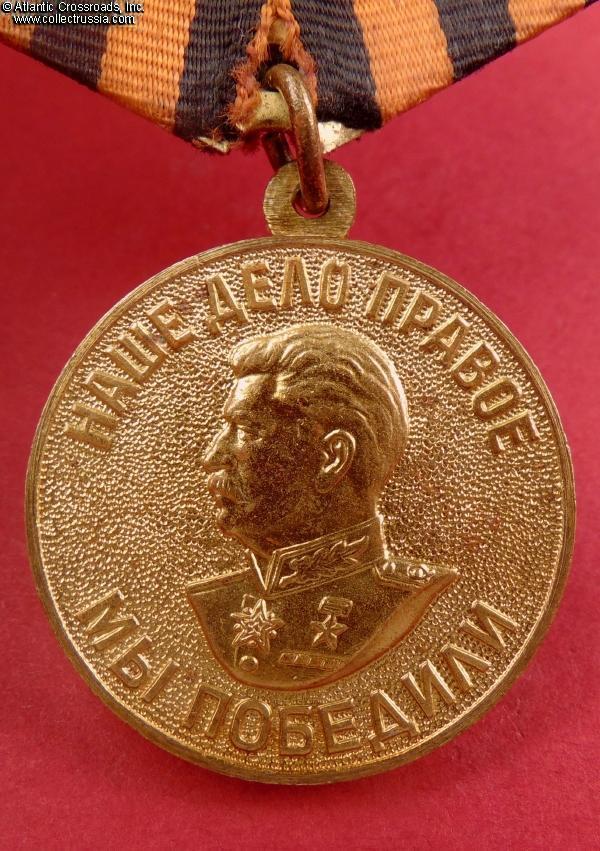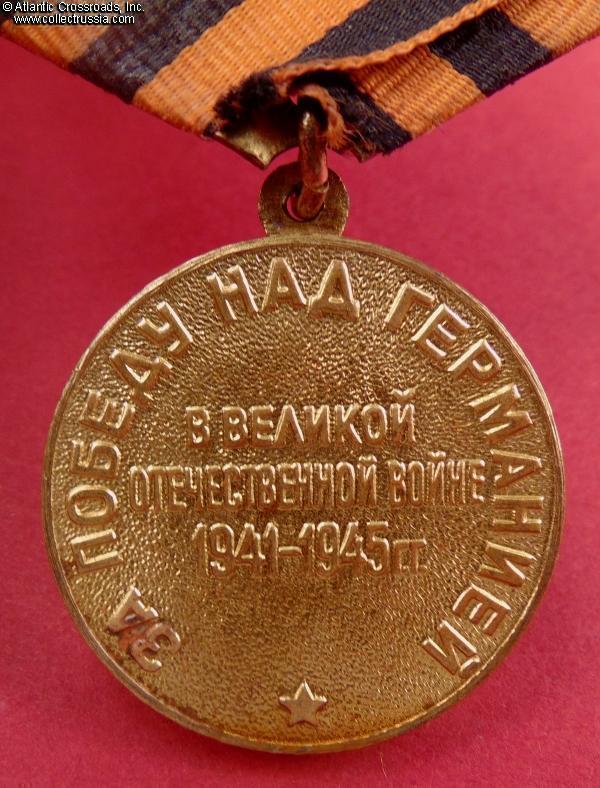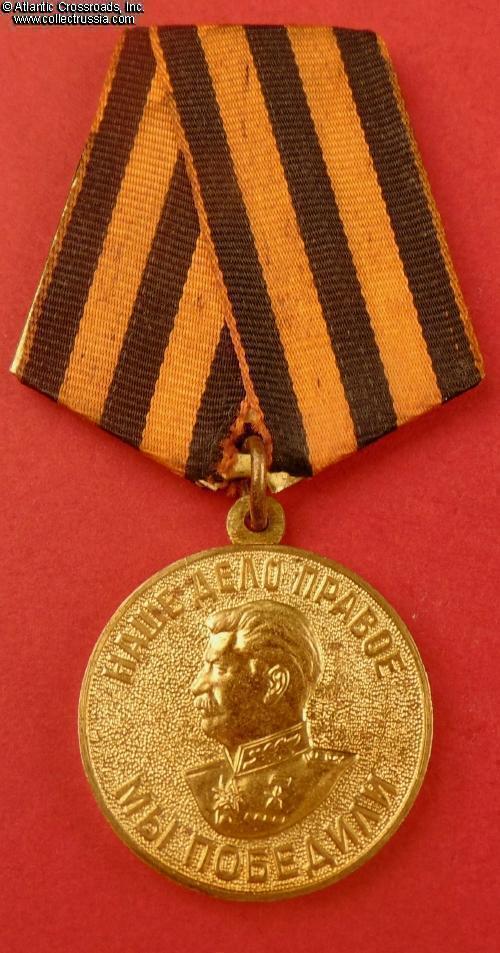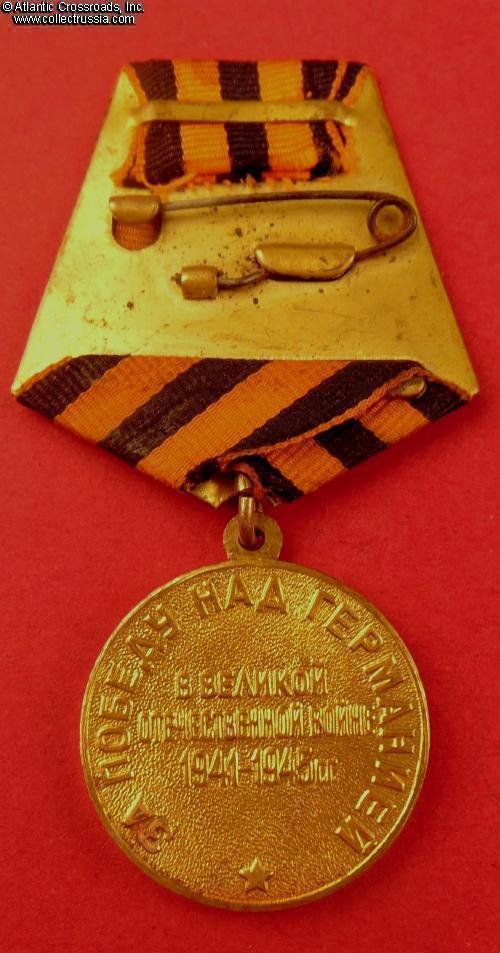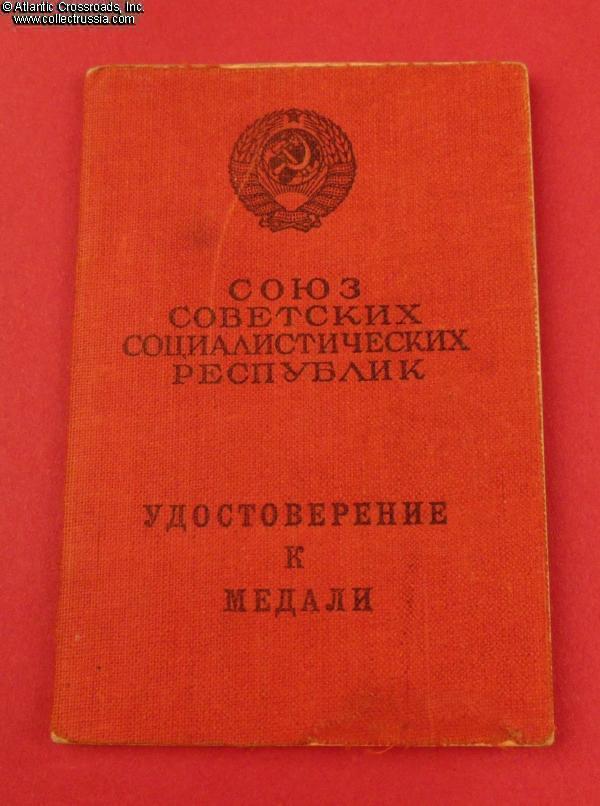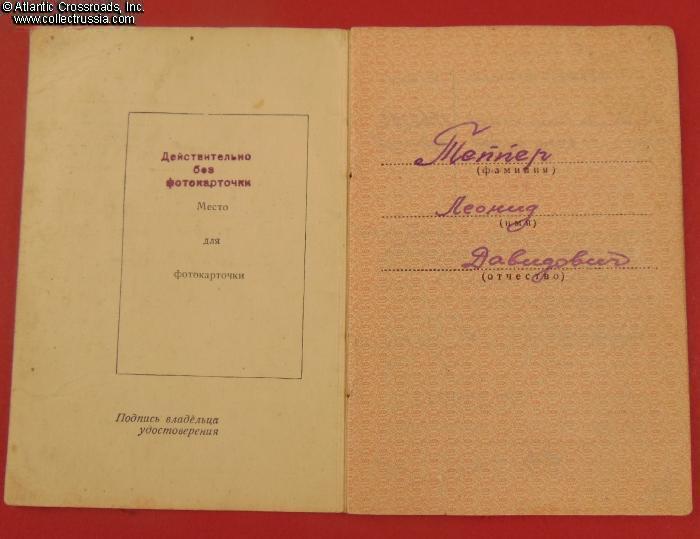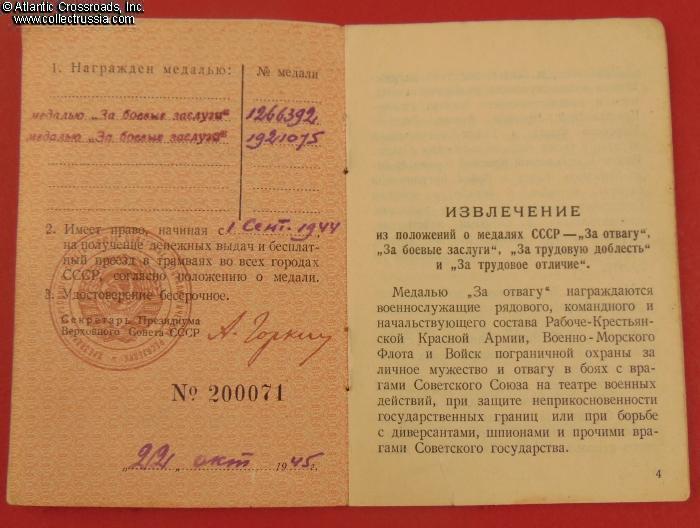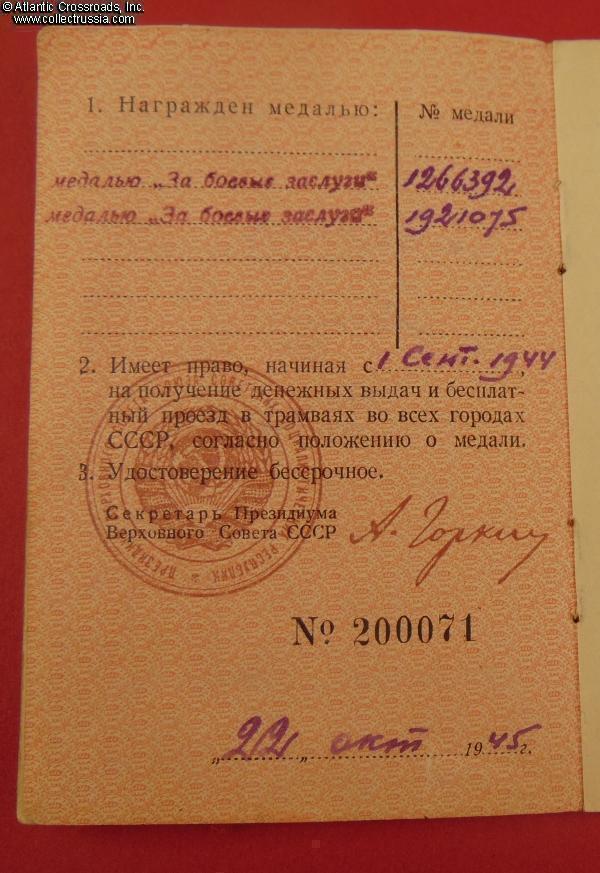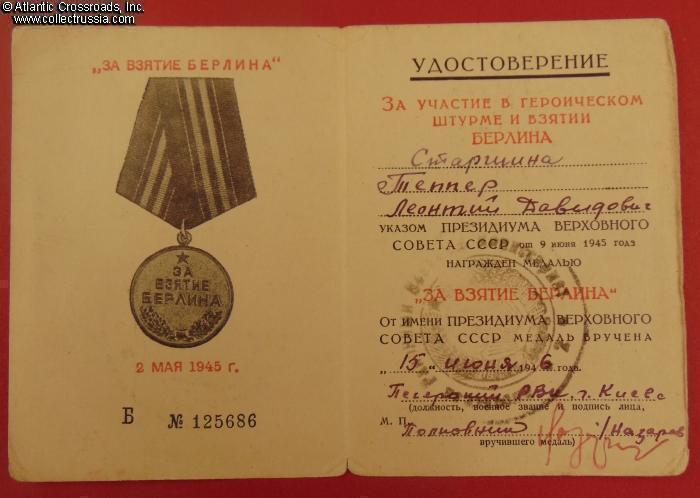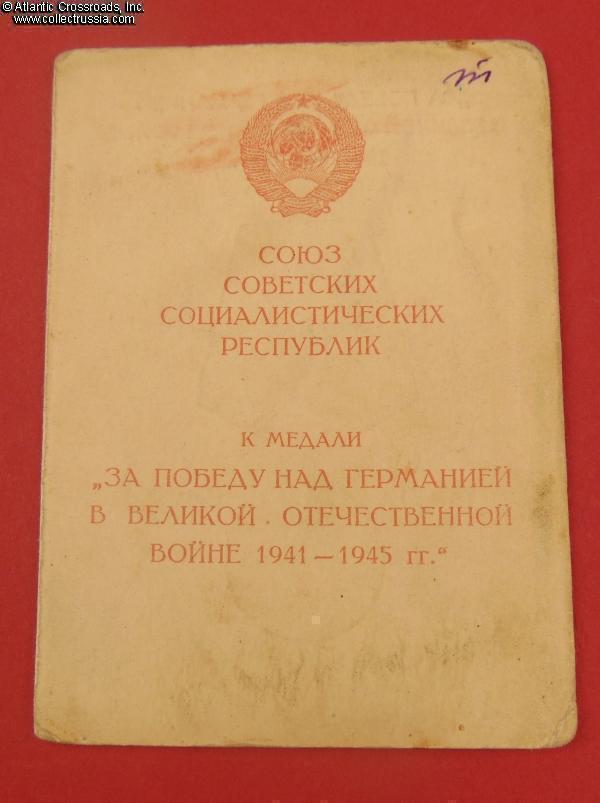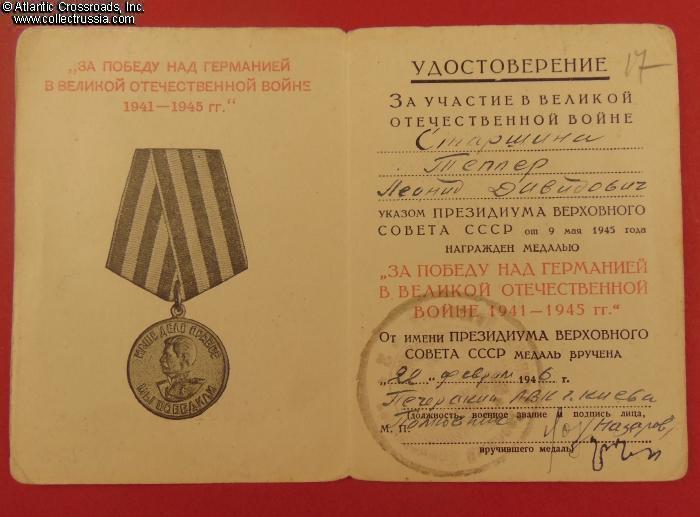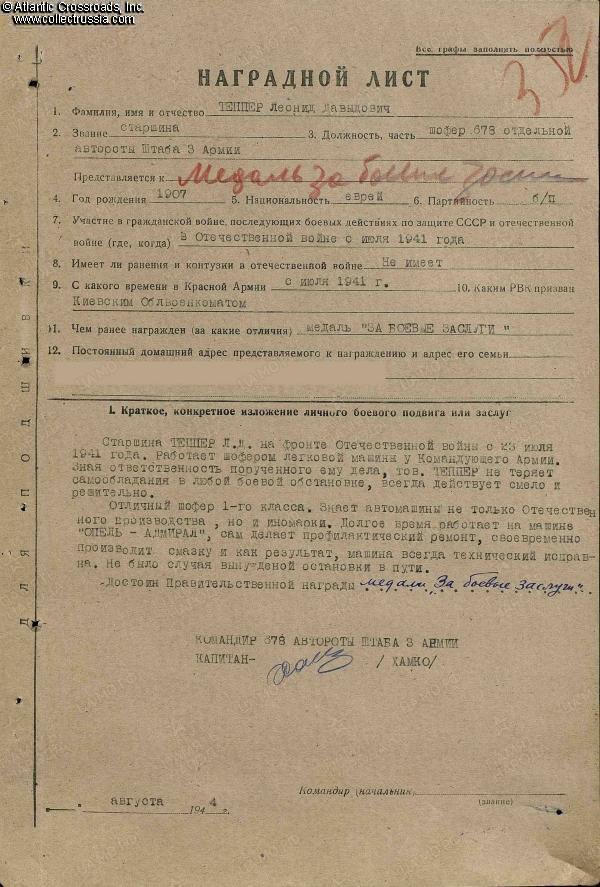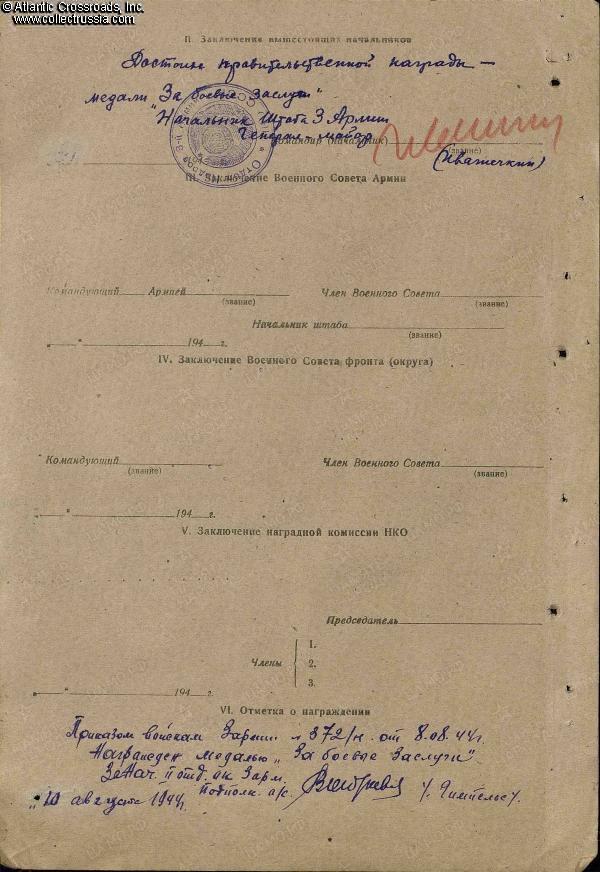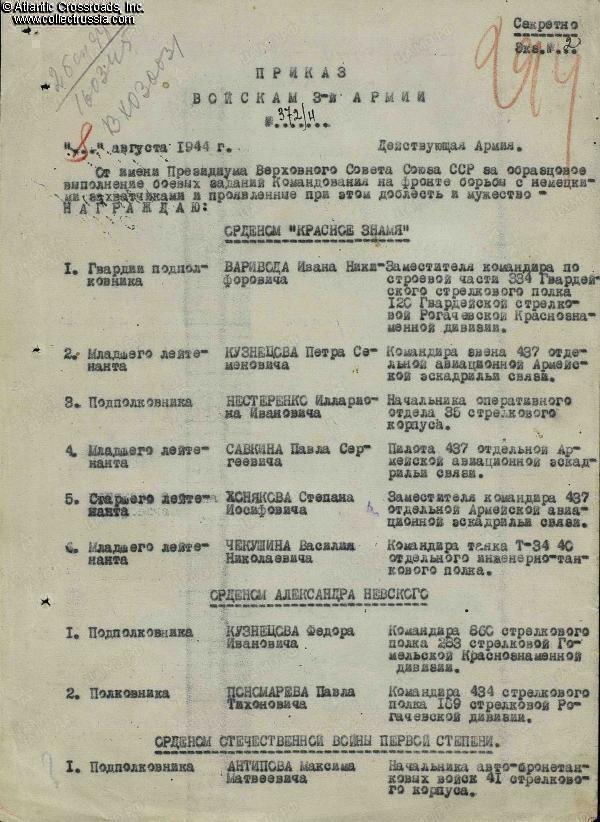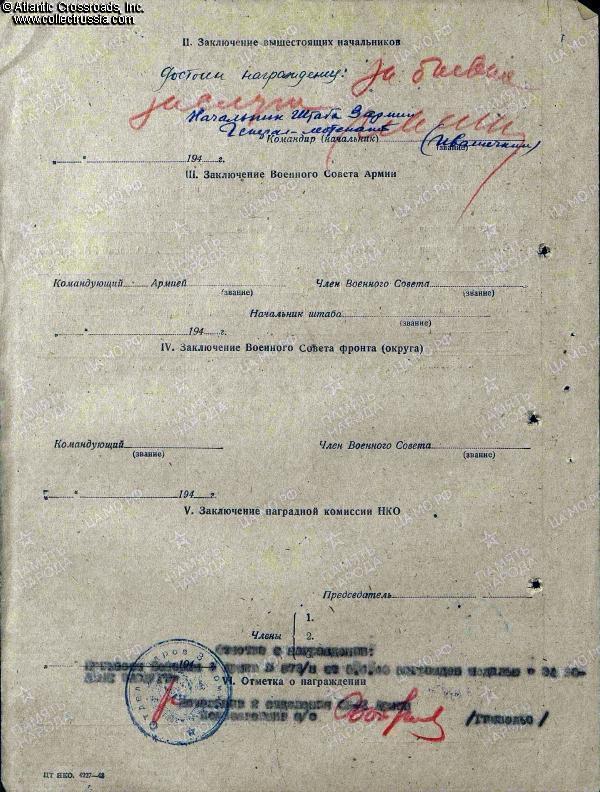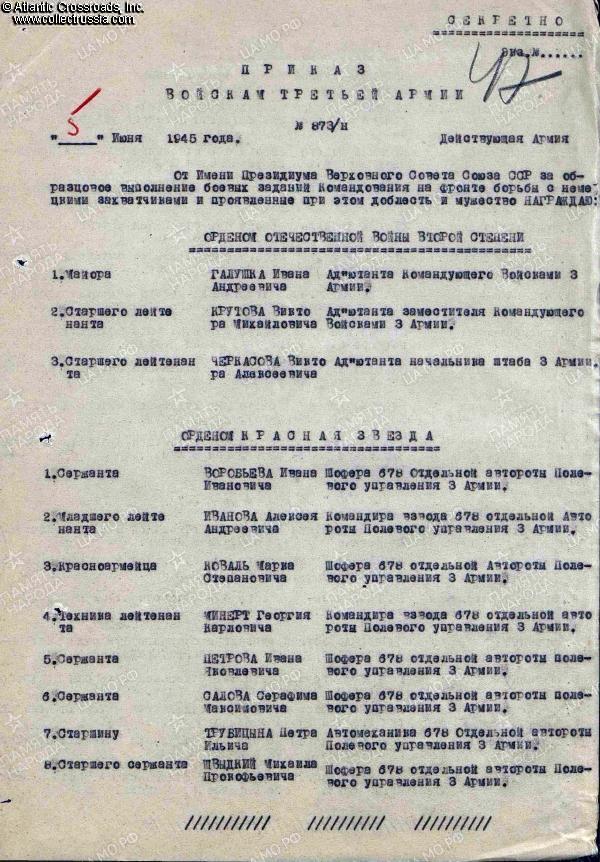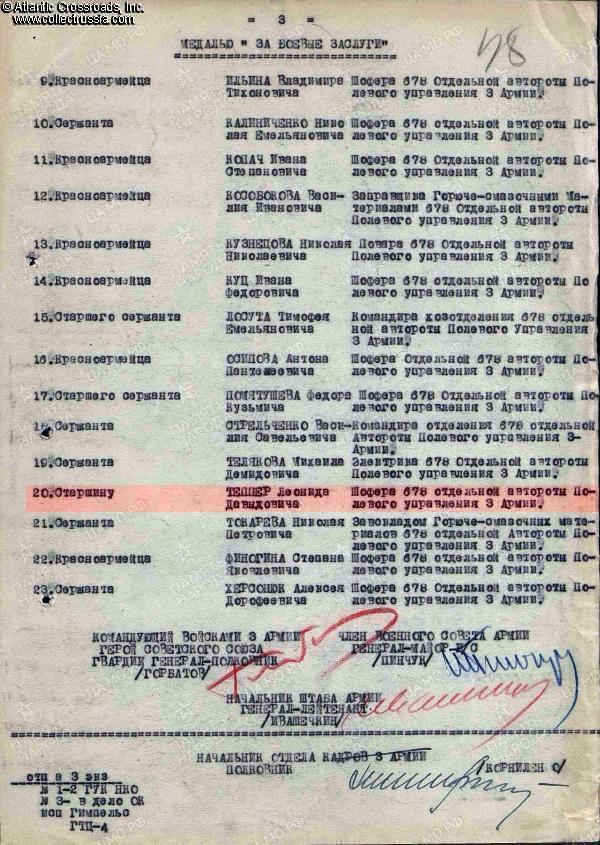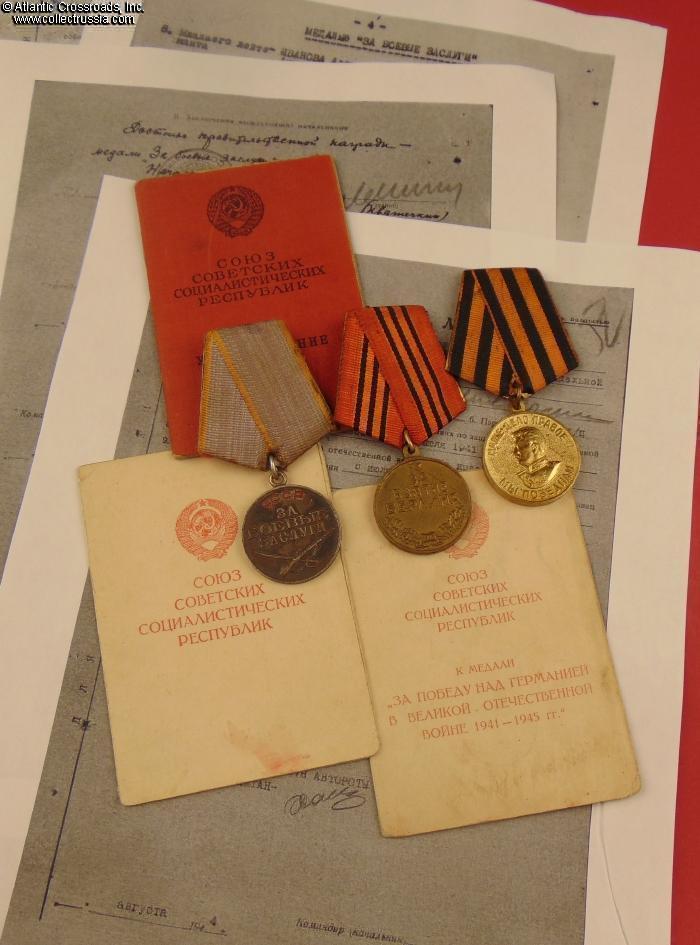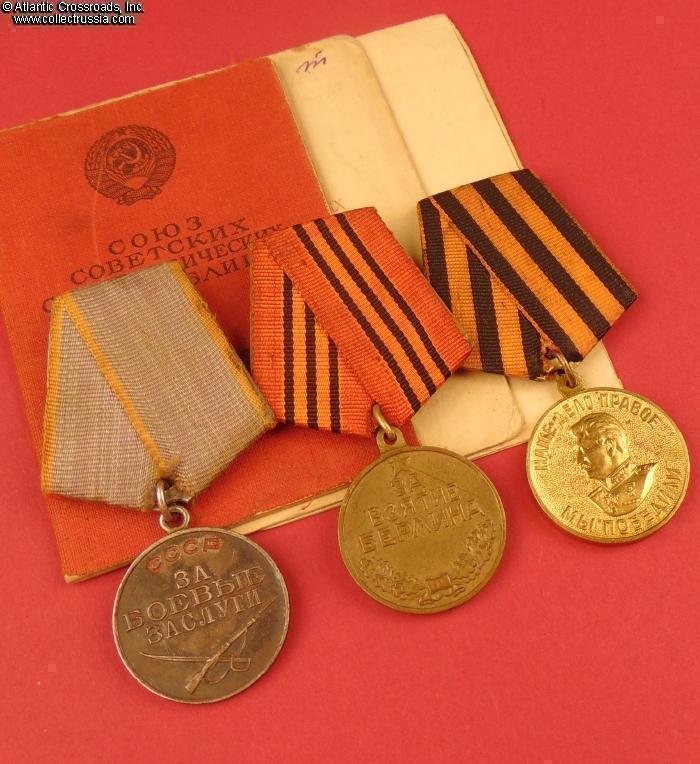
Documented Group of Three Awards to Sergeant Major Leonid Tepper (Леонид Давыдович Теппер).
Medal for Combat Service, Type 2 Variation 2, 1266392. The medallion is in silver and lacquer; 32.3 mm wide; weighs 17.1 g not including the suspension and connecting link. Features separate, soldered eyelet and straight saber hilt.
In excellent condition. The medallion shows practically no wear beside a few minuscule dings to the raised edge that are almost unnoticeable to the naked eye. The raised details of the rifle, sword and lettering are perfect and crisp. The original red lacquer in the letters is completely intact which is very uncommon for a Combat Service
Medal for Combat Service, Type 2 Variation 2, 1266392. The medallion is in silver and lacquer; 32.3 mm wide; weighs 17.1 g not including the suspension and connecting link. Features separate, soldered eyelet and straight saber hilt.
In excellent condition. The medallion shows practically no wear beside a few minuscule dings to the raised edge that are almost unnoticeable to the naked eye. The raised details of the rifle, sword and lettering are perfect and crisp. The original red lacquer in the letters is completely intact which is very uncommon for a Combat Service Medal of WWII period (most of them have the lacquer either completely worn-out or replaced). There is a very attractive dark patina to silver on both sides.
The medal comes on an original WW2 suspension, a two-layer model in steel. The old, possibly original ribbon is very well-preserved and sound. The silver connecting link between the medal and suspension appears to be original, and its ends are still joined with solder.
Medal for the Capture of Berlin, Variation 2. In brass; 32.1 mm wide; weighs 17.4 not including the suspension and connecting link. Excellent condition. The only visible sign of wear is a thin scratch in the upper part of the obverse which is not too detractive. The medallion is otherwise pristine; its details are perfect. There is an attractive even patina throughout with just a single small blemish on the reverse; some of the original "gilt" mint luster is visible in recessed areas, especially along the edge and on the eyelet. Comes on a brass suspension of an early post-war model with a well-preserved old ribbon.
Medal for Victory over Germany, Variation 2. In brass, 32.4 mm wide. In excellent condition. The medallion is free of significant wear and shows only a few microscopic contact marks. The raised details are perfect and exceptionally crisp. The original mint luster is well- preserved and bright, showing only a few tiny oxidation spots. Comes on a brass suspension of an early post-war model with a well-preserved old ribbon.
Medal Certificate, #20071, issued on 22 October 1945. Wrapped in red cloth, very similar in format to a WW2 order booklet. The document has entries for two Combat Service Medals, #1266392 and #1921075. The starting date for special privileges is September 1944, which corresponds with the August 1944 award date of the first medal (in this case, #1266392.)
The document is in excellent condition. The cover shows only a minimal amount of wear. The binding is tight. The internal pages are perfectly clean and sound. There are small tears to the bottom of some of the pages, not affecting the text or overall look of the document.
Award Document for the Capture of Berlin Medal, #B-125686, issued on 15 June 1946. Shows a stamp of the Military Commissariat of the Pecherskiy District of Kiev and hand-signed by the Military Commissar of the District, Col. Nazarov. In very good to excellent condition. There is a minor stain on the front cover and a single hand-written note on the back. The interior is perfectly clean.
Award Document for the Victory over Germany Medal, issued on 22 February 1946. Shows a stamp of the Military Commissariat of the Pecherskiy District of Kiev and hand-signed by the Military Commissar of the District, Col. Nazarov. The document is in very good to excellent condition, still sound and showing only a minor wear.
Born in 1907 to an ethnic Jewish family in the city of Omsk, Leonid Tepper originally joined the Red Army in 1927, probably to serve a stint as a conscript. He served in the military again during the Soviet invasion of Poland in 1939 and the Winter War against Finland in 1940-41. Discharged prior to the Patriotic War, he was recalled to active duty immediately after the German invasion of the Soviet Union in June 1941 and was soon sent to the front. Thanks probably to his prior experience as a driver, he was appointed to the automobile company with the staff of the 3rd Army. Well before his first award recommendation in August 1944, he became the personal driver of the Army commander Col. General Gorbatov.
[A very capable and charismatic officer who started service under the Imperial regime, Gorbatov fought in some of the key battles of WW1 and earned two St. George Crosses and two Medals for Bravery. He joined the Bolsheviks soon after the revolution, fought in the Civil War as a Red Army cavalry regiment commander, and later advanced through the ranks becoming a cavalry corps commander in the Kiev Military District. For all his efforts, he was arrested in 1937 during the Great Purge, brutally tortured, convicted of "counterrevolutionary activities", and sent to a northern prison camp where he nearly died of scurvy and hunger. Gorbatov was released from prison in March 1941, just in time to recuperate before the upcoming war with Germany. He commanded a cavalry corps at Stalingrad before being put in charge of the 3rd Army, the position Gorbatov would hold from June 1943 through the end of the war. For his outstanding leadership, he was awarded with many decorations and in April 1945, was made a Hero of the Soviet Union. Soon after the end of the war in Europe, Gorbatov was appointed Commandant of Berlin and later, chief of Soviet administration of two provinces of Germany. In the early half of the 50s, he commanded an airborne army and briefly, the entire Soviet airborne forces before becoming the Commander of the Baltic Military District and getting promoted to General of the Army (equivalent of a marshal). Gorbatov died in 1973 and was buried in Moscow with full honors. Interestingly, this remarkable Soviet officer never in his life drank alcohol, smoke, or swore - making a great contrast with the rest of his cohort.]
Sgt. Maj. Tepper proved indispensable in his role as Gorbatov's personal driver. According to the commendation for his Combat Service Medal, Tepper always acted courageously and resolutely, "never losing presence of mind regardless of the situation". It is interesting to see that among the various car models he drove was a captured German Opel Admiral, an especially valuable prize. Tepper always took utmost care of the vehicle ensuring that there was not a single case when it broke down while driving the army commander.
The Combat Service Medal #1266392 awarded to Tepper on 8 August 1944 was apparently his first decoration of the war (the award commendation mentions another Medal for Combat Service awarded previously, but that is obviously a clerical error: the other archival records as well as the document included with the group show that there were no prior awards.) Tepper continued to serve as the personal driver of Col. Gen. Gorbatov until the end of the war. With his army, he took part in the Battle of Kursk, Bagration Offensive in Belorussia, offensive in East Prussia (for which his commander Gorbatov received the title of Hero of the Soviet Union), and the Battle of Berlin, ending the war on the Elbe River northeast of Magdeburg. In June 1945, he was awarded with a second Combat Service Medal, his final decoration of WW2, for diligent service throughout the war. Judging by his WW2 campaign medal documents, as of February 1946 Tepper had been discharged from active duty in the military and returned to the city of Kiev where he lived before the war.
Research Materials: photocopy of the award commendations for the two Combat Service Medals from the Russian archival website
podvignaroda.ru.
$275.00 Add to cart

